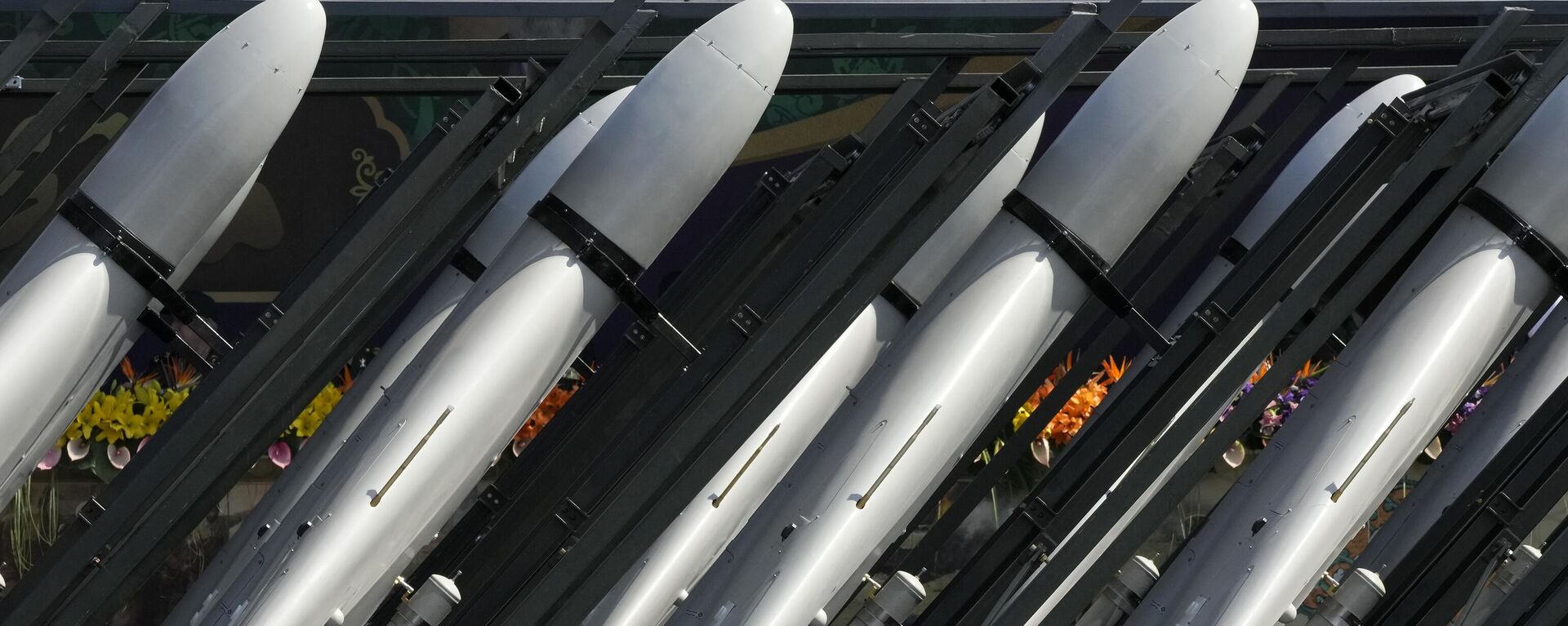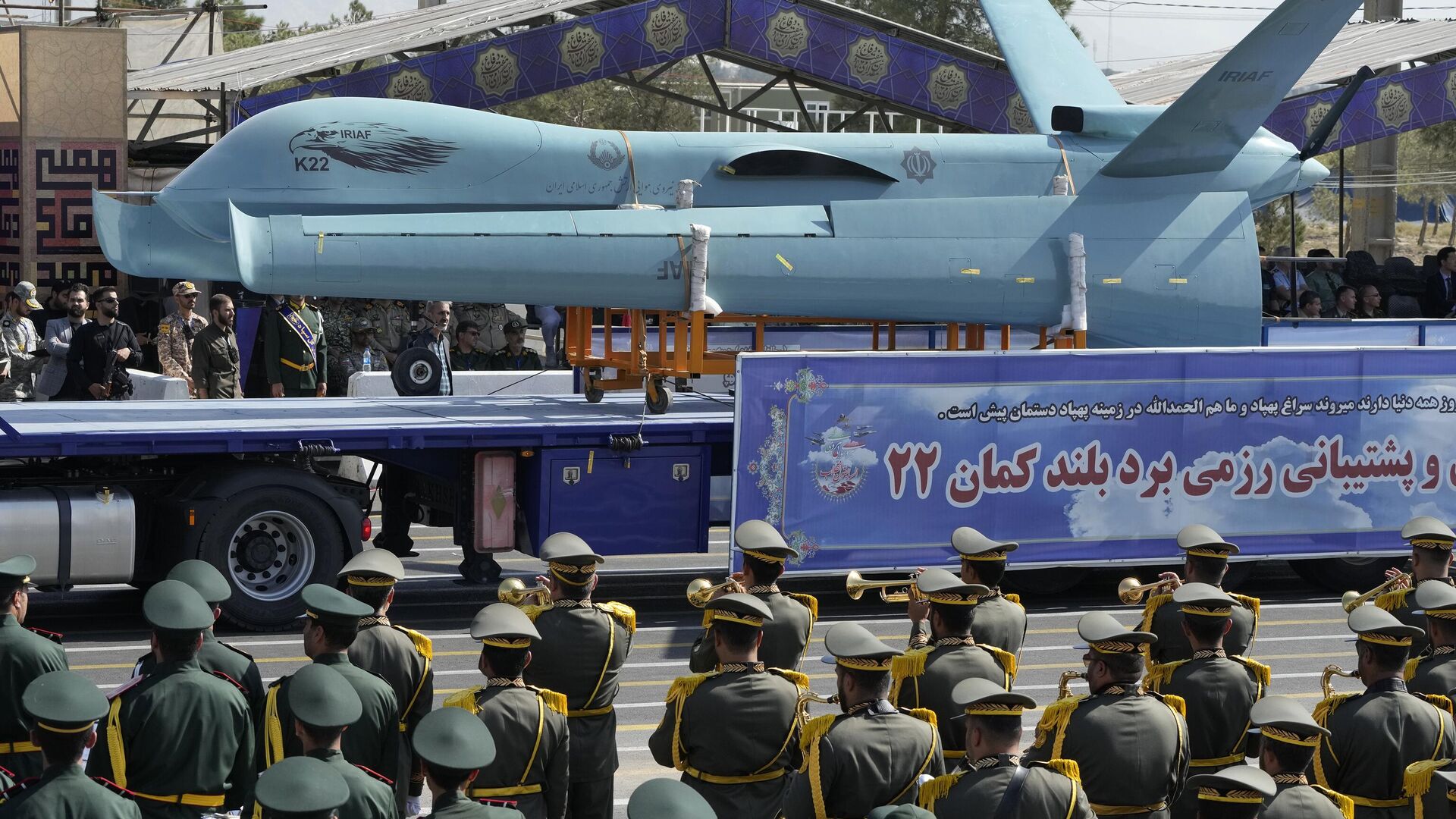https://sputnikglobe.com/20230925/iran-boasts-of-hybrid-drones-capability-warns-of-hair-trigger-response-to-any-aggression-1113664837.html
Iran Boasts of Hybrid Drones’ Capability, Warns of Hair-Trigger Response to Any Aggression
Iran Boasts of Hybrid Drones’ Capability, Warns of Hair-Trigger Response to Any Aggression
Sputnik International
The Islamic Republic has developed dozens of increasingly sophisticated turboprop and rocket-powered aerial unmanned aerial vehicles over the decades, designed for missions ranging from aerial reconnaissance to long-range precision strikes against land and sea targets.
2023-09-25T18:26+0000
2023-09-25T18:26+0000
2023-09-25T18:26+0000
military
alireza tangsiri
mohammad baqeri
kiomars heidari
persian gulf
washington
iranian armed forces
islamic revolutionary guard corps (irgc)
iran
drone
https://cdn1.img.sputnikglobe.com/img/07e7/09/17/1113606979_0:160:3072:1888_1920x0_80_0_0_7bad57bf93a5421b559c3ffae6f4abe3.jpg
Iran has reportedly developed a new hybrid aerial and sea-based drone capable of landing on and taking off from water, with senior military officials calling on Persian Gulf nations to ensure security collectively, while warning Washington and its allies of the consequences any aggressive moves.“The IRGC Navy has also built hybrid drones that fly with one engine, with the second engine serving as a propelling engine,” Tangsiri said. That UAV is said to have the capability to carry out reconnaissance missions lasting up to 15 hours.The water-landing drones, reportedly designed to be able to carry missiles and bombs, would dramatically enhance the IRGC Navy’s already substantial naval and coastal defense capabilities in the defense of the nation’s vast coastlines in the Persian Gulf, along the crucial world energy transportation chokepoint in the Strait of Hormuz, and in the Gulf of Oman.Tangsiri reiterated Tehran’s long-standing diplomatic stance that Persian Gulf security can be assured by regional countries, without any interference from non-Gulf countries, and proposed the creation of an eight-nation pact of Persian Gulf-adjacent countries to ensure regional security, including Iran, Bahrain, Iraq, Kuwait, Oman, Qatar, Saudi Arabia and the United Arab Emirates.The opportunities to forge such a regional security pact shot up dramatically this spring after Iran and Saudi Arabia signed a surprise normalization of relations deal mediated by China. Washington, Riyadh’s longtime traditional partner in the region, was forced to begrudgingly accept the warming of relations between the traditional Gulf foes, while expressing skepticism over the agreement’s ability to last, and leveling new sanctions against the Islamic Republic.Separately, at a military ceremony outside Qom, central Iran on Monday, Iranian Armed Forces Chief of Staff Mohammad Baqeri warned Iran’s potential enemies that the nation’s military is on a hair-trigger alert to respond instantaneously to any aggression.“The Iranian Armed Forces have set up a unified body to establish security in the country,” Baqeri said. “State of readiness is a familiar concept for our armed personnel. That is, every moment we have our hands on the trigger and our eyes on the radar screen, along with surveillance and intelligence equipment so that no conspiracy is organized against the country and the enemies do not wish to launch aggression and undermine our security,” the top commander added.Also speaking at the event, Iranian Army Ground Forces Commander Kioumars Heidari warned that “if the enemies put a foot wrong and commit a foolish or mischievous act” against Iran, they “will receive a decisive response from the Army’s ground forces.”“If the enemies attack Iran from the air, they will have no place to sit on the ground, and if they attack Iran from the ground, we will annihilate them within seconds by God’s grace,” Heidari added.Iran unveiled a new ultra-long range drone last week at a military parade dedicated to the Iran-Iraq War of 1980-1988, with the UAV, named the Mohajer-10, capable of flying up to 2,000 km with a weapons payload of up to 300 kg, able to stay airborne for up to 24 hours at a time.Regional tensions flared between the Iran and the US have recent months amid Washington’s decision to dramatically ramp up its naval, air and troop presence in the Persian Gulf following Iran’s crackdown on oil smuggling and maritime navigation violators.Last month, IRGC Navy Commander Tangsiri stressed that the large US warships traversing Persian Gulf waters have been forced to obey Iran’s maritime rules.Armed with an impressive and technically advanced military-industrial complex, Iran’s military design philosophy seems aimed at providing the country with David vs. Goliath-type asymmetric warfare capabilities against larger and technically more powerful adversaries, with the country building up mosquito fleets of fast boats armed with machineguns and artillery, hundreds of coastal defense batteries, dozens of drone designs, and maritime power projection capabilities using old tanker ships converted into mobile support platforms to save on costs. Iran’s strategy has enabled it to become one of the top 20 militarily most powerful countries in the world, while spending just a fraction of what the US does on defense ($6.8 billion vs $877 billion in 2022).
https://sputnikglobe.com/20230923/iran-presents-top-tier-weaponry-at-annual-military-parade-1113605515.html
persian gulf
washington
iran
Sputnik International
feedback@sputniknews.com
+74956456601
MIA „Rossiya Segodnya“
2023
News
en_EN
Sputnik International
feedback@sputniknews.com
+74956456601
MIA „Rossiya Segodnya“
Sputnik International
feedback@sputniknews.com
+74956456601
MIA „Rossiya Segodnya“
iran, united states, drone, unmanned aerial vehicle, hybrid, water, landing, water landing, islamic revolutionary guard corps, irgc, capabilities
iran, united states, drone, unmanned aerial vehicle, hybrid, water, landing, water landing, islamic revolutionary guard corps, irgc, capabilities
Iran Boasts of Hybrid Drones’ Capability, Warns of Hair-Trigger Response to Any Aggression
The Islamic Republic has developed dozens of increasingly sophisticated turboprop and rocket-powered unmanned aerial vehicles over the decades, designed for missions ranging from reconnaissance to long-range precision strikes against land and sea targets.
Iran has reportedly developed a new hybrid aerial and sea-based drone capable of landing on and taking off from water, with senior military officials calling on Persian Gulf nations to ensure security collectively, while warning Washington and its allies of the consequences any aggressive moves.
“The Islamic Revolutionary Guard Corps Navy has built drones that can take off from and land on the water,” IRGC Commander Ali Reza Tangsiri
said in an interview with local media over the weekend, pledging that more details about the drone will be provided at a later date.
“The IRGC Navy has also built hybrid drones that fly with one engine, with the second engine serving as a propelling engine,” Tangsiri said. That UAV is said to have the capability to carry out reconnaissance missions lasting up to 15 hours.
The water-landing drones,
reportedly designed to be able to carry missiles and bombs, would dramatically enhance the IRGC Navy’s already substantial naval and coastal defense capabilities in the defense of the nation’s vast coastlines in the Persian Gulf, along the crucial world energy transportation chokepoint in the Strait of Hormuz, and in the Gulf of Oman.
Tangsiri
reiterated Tehran’s long-standing diplomatic stance that Persian Gulf security can be assured by regional countries, without any interference from non-Gulf countries, and proposed the creation of an eight-nation pact of Persian Gulf-adjacent countries to ensure regional security, including Iran, Bahrain, Iraq, Kuwait, Oman, Qatar, Saudi Arabia and the United Arab Emirates.
The opportunities to forge such a regional security pact shot up dramatically this spring after Iran and Saudi Arabia signed a surprise normalization of relations deal mediated by China. Washington, Riyadh’s longtime traditional partner in the region, was forced to begrudgingly accept the warming of relations between the traditional Gulf foes, while expressing skepticism over the agreement’s ability to last, and leveling new sanctions against the Islamic Republic.
Separately, at a military ceremony outside Qom, central Iran on Monday, Iranian Armed Forces Chief of Staff Mohammad Baqeri warned Iran’s potential enemies that the nation’s military is on a hair-trigger alert to respond instantaneously to any aggression.
“The Iranian Armed Forces have set up a unified body to establish security in the country,” Baqeri
said. “State of readiness is a familiar concept for our armed personnel. That is, every moment we have our hands on the trigger and our eyes on the radar screen, along with surveillance and intelligence equipment so that no conspiracy is organized against the country and the enemies do not wish to launch aggression and undermine our security,” the top commander added.
Also speaking at the event, Iranian Army Ground Forces Commander Kioumars Heidari warned that “if the enemies put a foot wrong and commit a foolish or mischievous act” against Iran, they “will receive a decisive response from the Army’s ground forces.”
“If the enemies attack Iran from the air, they will have no place to sit on the ground, and if they attack Iran from the ground, we will annihilate them within seconds by God’s grace,” Heidari added.
Iran
unveiled a new ultra-long range drone last week at a military parade dedicated to the Iran-Iraq War of 1980-1988, with the UAV, named the Mohajer-10, capable of flying up to 2,000 km with a weapons payload of up to 300 kg, able to stay airborne for up to 24 hours at a time.

23 September 2023, 10:48 GMT
Regional tensions flared between the Iran and the US have recent months amid Washington’s decision to dramatically ramp up its naval, air and troop presence in the Persian Gulf following Iran’s crackdown on oil smuggling and maritime navigation violators.
Last month, IRGC Navy Commander Tangsiri
stressed that the large US warships traversing Persian Gulf waters have been forced to obey Iran’s maritime rules.
Armed with an impressive and technically advanced military-industrial complex, Iran’s military design philosophy seems aimed at providing the country with David vs. Goliath-type asymmetric warfare capabilities against larger and technically more powerful adversaries, with the country building up mosquito fleets of fast boats armed with machineguns and artillery, hundreds of coastal defense batteries, dozens of drone designs, and maritime power projection capabilities using old tanker ships converted into mobile support platforms to save on costs. Iran’s strategy has enabled it to become
one of the top 20 militarily most powerful countries in the world, while spending just a fraction of what the US does on defense (
$6.8 billion vs $877 billion in 2022).



